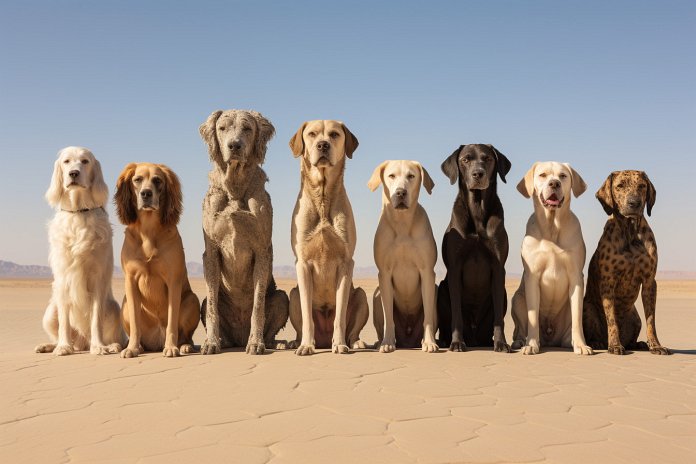
Elvis Presley’s song “you ain’t nothing but a hound dog” couldn’t have foreshadowed the incredible abilities of our canine companions. Dogs have taken over the world, becoming our beloved pets, defenders of our nation, and even archaeologists. They sniff out drugs, uncover ancient graves and sites, and help solve crimes. The depth of their olfactory talents is still a mystery to scientists, but we continue to be amazed by their abilities.
Signs a Dog Can Sense Petrified Fossils
Cadaver dogs, trained to detect decomposing bodies, have aided police in solving cases where bodies were missing. Archaeology dogs, on the other hand, go even further back in time, unearthing graves and sites from ancient civilizations. These dogs, such as Andrea Pinter’s Belgian Malinois named Mali, use their powerful noses to sniff out antiquity. They alert their handlers through various signals, such as barking or lying down and pushing their noses into the area. The reward for their discovery is a toy, tennis ball, or treat. The science behind what dogs can actually smell is still a mystery.
Body Language
When a dog detects ancient human remains, they display certain behaviors, such as alertness, barking, panting, wagging their tail, pacing, and sniffing. They may also paw at the area, sit near the bones, lie down, or bark to alert their handler.
History of Archaeology Dogs
Dogs have inherited their incredible sense of smell from their ancestor, the wolf. They can not only detect hidden drugs but also sense our stress levels. In fact, dogs are often better at detecting bombs than the gadgets invented by the Pentagon. Migaloo, a black Labrador cross, was possibly the first trained archaeology dog. She was able to detect bones dating back 600 years and even found fossils millions of years old. Crystal, a Beagle, is another remarkable archaeology dog, trained to sniff out dinosaur fossils.
The Science of Dogs Detecting Fossils
Dogs have an extraordinary sense of smell that allows them to discern the finest details of an object. They can detect the scent of a person who may have touched something and determine how long ago it happened. This is why bloodhounds can track missing people, and it may explain how archaeology dogs are able to locate buried bones. Fossils are usually found in sedimentary rock, and dogs’ ability to detect changes in barometric pressure and scent changes makes them well-suited for this task.
Training Archaeology Dogs
Training an archaeology dog is similar to training a dog to sniff out drugs or other scents. The dogs are initially taught basic obedience and then learn to choose the right scent. The reward for finding the scent is either a small towel or a beloved toy. Dogs quickly associate the reward with the appropriate scent, and their natural instincts take over. Dogs like Migaloo have a passion for their work and possess the necessary skills to locate hard-to-find remains.
Conclusion
Dogs have become indispensable in various fields, including archaeology. Their extraordinary sense of smell allows them to detect things that humans cannot, uncovering ancient graves and artifacts. While the science behind how they can detect petrified fossils is still a mystery, their abilities continue to astound us. Dogs truly are our greatest allies in unraveling the mysteries of the past.
“Dogs: the world’s most ancient archeologists, sniffing out history one bone at a time. And to think we’ve been using them as mere fetch players!”

Tips & Things to Know
1️⃣ Dogs have an exceptional sense of smell, which allows them to sniff out drugs, detect changes in human health, and even find petrified fossils. Their olfactory system is so finely-tuned that they can distinguish individual components of a scent, such as the different elements of a flower or the smell of a person who touched an object.
2️⃣ Archaeology dogs are specifically trained to detect the scent of old bones and have been used to assist in archaeological digs. The training process involves associating the scent of the bones with a reward, such as a toy or treat. Dogs with a strong play or prey drive are particularly good at this kind of work.
3️⃣ The ability of dogs to detect petrified fossils is still something of a mystery to scientists. It’s possible that the dogs are picking up on the scent of the rock or soil in which the fossils are buried, rather than the fossils themselves. Regardless of how they do it, archaeology dogs have proven to be a valuable tool in uncovering the past.
Frequently Asked Questions, Answered ✅
1. How do cadaver dogs assist police in solving cases where there are no bodies?
– Cadaver dogs pick up on chemicals emitted from decomposing bodies and can locate bodies even when there is no physical evidence.
2. What signs do dogs exhibit when they have detected ancient human remains?
– Dogs may bark, pant, wag their tail, pace, sniff, paw at the area, sit near the bones, or lie down and bark to alert their handler.
3. How do archeology dogs help in uncovering historical sites?
– Archeology dogs can sniff out old bones and graves, aiding archeologists in their quest for answers about the past.
4. How do dogs possess such an incredible sense of smell?
– Dogs have inherited their exceptional sense of smell from their ancestor, the wolf. They can detect minute details in a scent and can even identify individual components of a smell.
5. How are archeology dogs trained to detect petrified fossils?
– Archeology dogs are trained to associate the scent of ancient bones with a reward, such as a toy or a towel. Through training and reinforcement, they learn to locate and indicate the presence of petrified fossils.